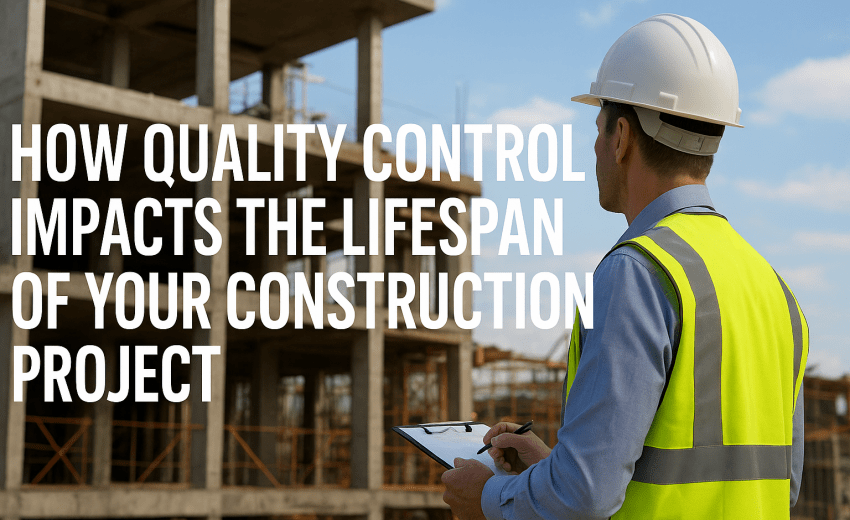
Table of Contents
Quality Control forms the backbone of every successful construction project. It’s the process that ensures every material, method, and milestone meets the required standards—ultimately determining how well a structure performs over time. From the foundation to the finishing touches, effective Quality Control practices directly influence the durability, safety, and value of a building, protecting both the client’s investment and the contractor’s reputation.
The Foundation of Excellence
At the start of any project, Quality Control begins with meticulous planning. This includes defining project specifications, choosing approved materials, and setting performance benchmarks. When these measures are implemented early, they minimize risks, prevent rework, and ensure that each phase aligns with engineering and safety standards. Proper oversight also identifies potential design conflicts before they turn into structural issues, saving both time and money in the long run.
Material Integrity Matters
The materials used in construction directly affect the longevity of a building. Without stringent Quality Control checks, substandard materials can compromise the entire structure, leading to early deterioration. Regular inspection of raw materials—such as concrete, steel, insulation, and waterproofing components—ensures compliance with industry regulations and design requirements. When materials meet consistent quality standards, they enhance resistance against wear, weather, and environmental stress.
Precision in Execution
Even the best materials can underperform if not installed correctly. Quality Control plays a vital role during on-site execution by ensuring that construction techniques are consistent with project drawings and engineering guidelines. Trained supervisors and inspectors verify every step, from formwork alignment to reinforcement placement, ensuring each phase meets safety and precision standards. This attention to detail significantly enhances the structural stability and extends the overall lifespan of the project.
Safety and Compliance
Beyond structural soundness, Quality Control ensures adherence to safety codes and environmental regulations. Poor workmanship or overlooked inspection points can lead to accidents, legal liabilities, or non-compliance penalties. Regular audits and documentation not only safeguard workers but also assure clients that the project meets all required certifications. A construction site governed by effective Quality Control becomes a benchmark for safety, reliability, and professionalism.
Preventing Costly Repairs
A common misconception is that Quality Control increases project costs. In reality, it reduces long-term expenses by preventing future maintenance and repair work. Projects with rigorous oversight experience fewer defects, lower operational issues, and reduced downtime. For instance, identifying a weak concrete mix during pouring is far less expensive to correct than dealing with structural cracks years later. Quality Control ensures that preventive measures are always prioritized over reactive fixes.
Enhancing Client Confidence
Quality assurance isn’t just about compliance—it’s also about trust. Clients feel more confident investing in projects managed with strict Quality Control systems because they know every component has been verified and approved. This assurance fosters stronger relationships, repeat business, and positive referrals, helping contractors build a reputation for excellence. In a competitive market like Dubai, where world-class standards are expected, this reputation becomes a powerful differentiator.
Technology and Modern Inspection
With advancements in technology, Quality Control has become more precise and data-driven. Drones, 3D scanning, and real-time monitoring tools help inspectors identify issues instantly, improving accuracy and efficiency. These innovations allow for predictive analysis—anticipating problems before they occur. Integrating such technologies ensures projects meet the highest standards while keeping schedules and budgets under control.
Sustainability Through Quality
Modern construction goes beyond aesthetics—it embraces sustainability. Quality Control ensures that energy-efficient materials, eco-friendly systems, and sustainable building practices are properly implemented. From proper insulation installation to efficient HVAC systems, maintaining quality helps reduce energy consumption and operational costs over time. The result is a longer-lasting, greener structure that benefits both the environment and the occupants.
Conclusion
In essence, Quality Control is not a formality—it’s the foundation of every lasting construction project. It ensures that every nail, beam, and block is placed with precision, backed by standards that guarantee safety, strength, and sustainability. When contractors prioritize Quality Control, they aren’t just building structures—they’re building trust, longevity, and a legacy of excellence.
Ready to Build with Confidence?
Get in touch with Charminar to learn how our project management expertise can streamline your next development.
📧 contact@bluediamondfm.com
📞 +971 56 705 4223
🌐 https://charminardubai.com/
Frequently Asked Questions (FAQ)
What does Quality Control mean in construction?
Quality Control in construction refers to systematic processes that ensure materials, workmanship, and methods comply with project specifications, codes, and standards.
How does Quality Control extend a building’s lifespan?
It ensures all components meet required strength and performance standards, preventing premature failures and reducing the need for major repairs or replacements.
Is Quality Control expensive to implement?
While it may add some upfront cost, it significantly reduces long-term expenses by avoiding rework, maintenance, and structural issues.
Who is responsible for Quality Control in a construction project?
Typically, site engineers, project managers, and Quality Control officers oversee implementation, supported by third-party inspections and testing agencies.
How can technology improve Quality Control?
Modern tools like drones, sensors, and 3D scanning provide real-time monitoring, helping identify and correct issues more accurately and efficiently.





